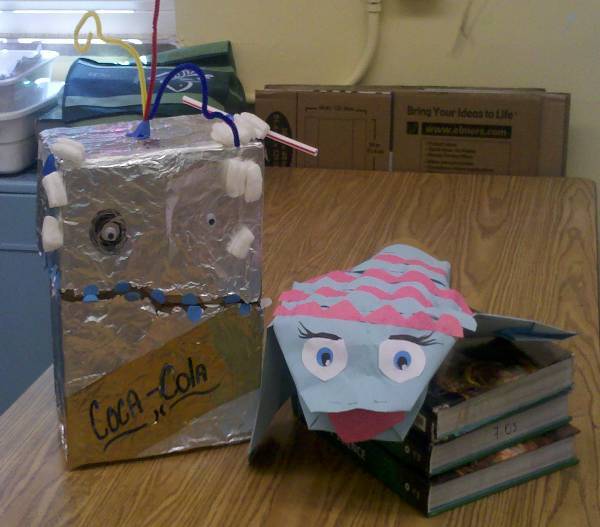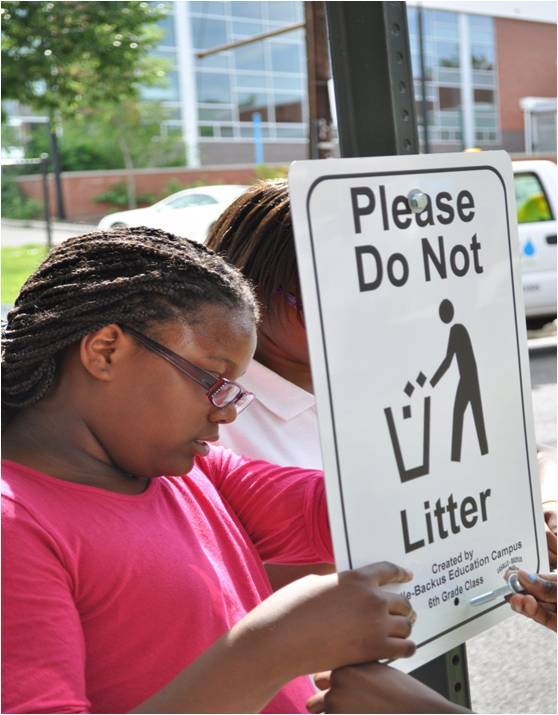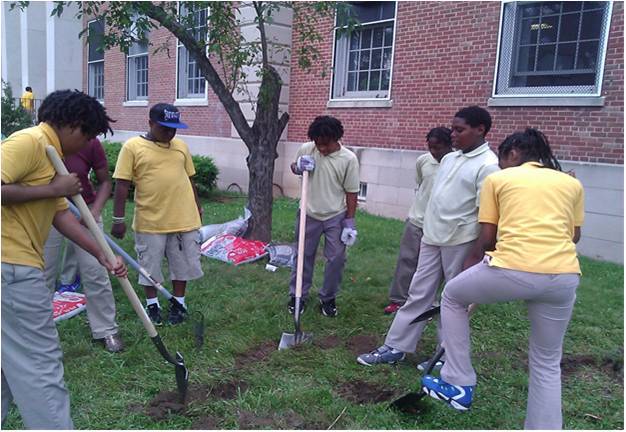2012 Washington DC, USA

After conducting surveys at their school, Brookland Education Campus sixth graders realized that few of their peers have of their peers had any awareness of the condition of their watershed, and they decided to work to raise and held a pep rally for the younger students at Brookland, so that their audience would better understand their impact on watershed health and commit to taking action to improve it.
Chesapeake Bay
Anti-Litter Signs
2012 Washington DC, USA

When students conducted water monitoring on a tributary of Sligo Creek, they were troubled by the extent of trash evident in and around the stream, and they decided to carry an anti-litter message through the neighborhood with anti-litter signs. They contacted the city government to obtain permission, and mapped out where to place the signs throughout the neighborhood for best effectiveness.
They designed signage online, and had the design produced as durable metal signs.
Rain Garden
2012 Washington DC, USA

Seventh graders at Jefferson Middle School in southwest DC wanted to address the pollutants that reach the Anacostia and Potomac Rivers through stormwater. They decided to create a rain garden at school to retain stormwater on-site. Enlisting the help of local nurseries in planning, they created a small rain garden featuring plants adapted to the Coastal Plain setting.
At the Caring for Our Watersheds finals, students shared a short video presentation on the importance of watershed stewardship and taking an active role in it. At the conclusion of their finals presentation, student Xavier H. Said, “i never did anything like this before, and I am happy to be part fo this project… I felt a great deal of pride because we did it.”
Batty About the Big Brown Bat
2012 Arlington, Virginia, USA

Students at H-B Woodlawn Secondary Program wanted to restore Big Brown Bat habitat in Arlington, noting that bats play an important role in the watershed as pollinators, insect pests predators, and source of natural fertilizer.
Working with bat experts and the staff at Potomac Overlook Regional Park, they developed their own bat box design and built and installed them at the park, mostly using donated materials. They also invited an expert from the Save Lucy the Bat Campaign to lead a school assembly to raise awareness among students about the importance of protecting endangered bats.
Tree Planting Project
2012 Arlington, Virginia, USA

Sixth graders at Kenmore Middle School noticed that the impervious surfaces of the built urban environment – roads, buildings, etc – cause increased storm-water run-off that local streams, including Four Mile Run. They decided they should address the problem by planting more trees to intercept rainfall and reduce run-off. Coordinating with Arlington County’s Landscape Ecologist, they arranged to plant trees, provided by the county, in Bluemont Park near the school campus.
Motor Oil Recycling for the Community (MORC)
2012 Washington, DC, USA

Following on the Roots Public Charter School’s 2011 Caring for Our Watersheds effort and proposal entry, students of the MORC (Motor Oil Recycling for the Community) project worked to raise community awareness of where and how to recycle used motor oil. They determined the neighborhood locations for motor oil recycling, and produced signs to let the community know where those locations are.
At the school’s Family Fun Day on June 9, students hosted a MORC activity booth to inform people of the closest recycling location to their home (since they had found that not all service stations in the area recycle oil as they out). At the Caring for Our Watersheds finals on June 4, the MORC project won 1st place, with a spirited presentation that included a mock newscast.
Students Create a Demonstration Garden to Showcase Native Plants
2011 Arlington, Virginia, USA

When sixth grade science students at H-B Woodlawn Secondary Program examined stream conditions at Gulf Branch in Arlington, they noticed that the vegetation alongside the stream was dominated by invasive species, including garlic mustard along the paths, Japanese honeysuckle growing out of logs, and English Ivy, its vines snaking their way up trees, on the ground and almost everywhere else. Following up with the county’s invasive plant coordinator, they arranged to join in a garlic mustard pull in the park and tour a native plants demonstration garden, where they helped plant native honeysuckle.
Continue reading

Students Share Outreach and Eco-Friendly Car Wash Solution(s) in their Community
2011 Alexandria, Virginia, USA

When visiting Holmes Run and collecting water quality data, seventh grade science students at Francis Hammond 1 Middle School were concerned that there was foam and trash coming directly out of a drainage pipe into a streamside marsh. After analyzing potential pollution sources, they decided they wanted to address contaminants running off residential streets into the storm drain system.
Continue reading
Earth Gardeners
2011 Alexandria, Virginia, USA
Seventh graders at Hammond Middle School wanted to demonstrate how organic gardening could reduce the amount of nutrients and pesticides that reach local waterways, including Holmes Run. They created a small vegetable garden in the school courtyard, using composted food scraps from the cafeteria.
From Shirts to Bags
2011 Alexandria, Virginia, USA
When they visited Holmes Run, Hammond Middle School seventh graders noticed trash, particularly plastics, in and around the stream. They chose to address this issue by promoting re-usable bags over throwaway plastic grocery bags. Their project created re-usable bags from tie-dyed t-shirts to give to students at Hammond and their families.